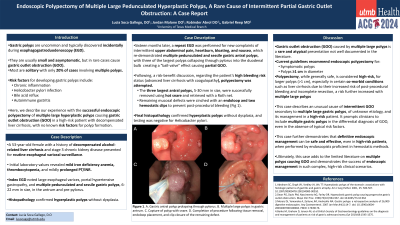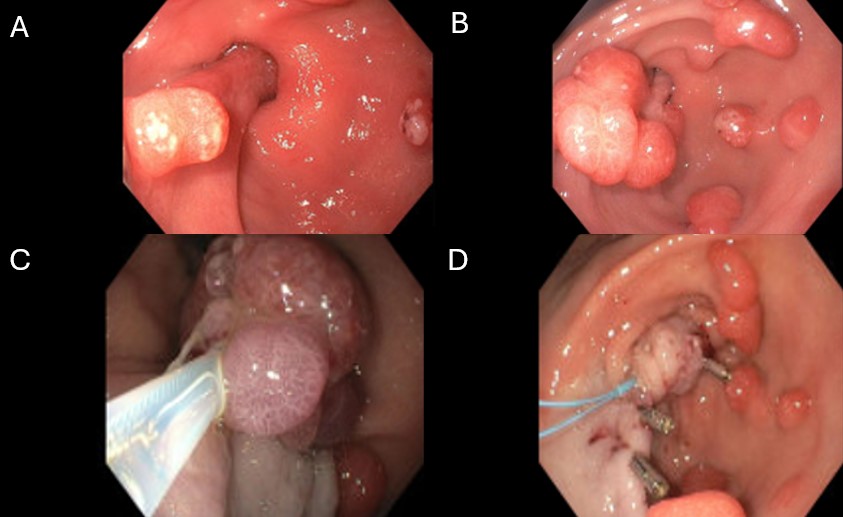Monday Poster Session
Category: Stomach
P3350 - Endoscopic Polypectomy of Multiple Large Pedunculated Hyperplastic Polyps, A Rare Cause of Intermittent Partial Gastric Outlet Obstruction: A Case Report
Monday, October 28, 2024
10:30 AM - 4:00 PM ET
Location: Exhibit Hall E

Has Audio

Lucia Soca Gallego, DO
University of Texas Medical Branch
Galveston, TX
Presenting Author(s)
Lucia Soca Gallego, DO, Jordan Malone, DO, Robinder Abrol, DO, Gabriel Reep, MD
University of Texas Medical Branch, Galveston, TX
Introduction: Gastric polyps are uncommon and normally discovered incidentally during esophagogastroduodenoscopy (EGD). Risk factors include chronic inflammation, Helicobacter pylori infection, bile acid reflux, and/or autoimmune gastritis. Most cases are small and asymptomatic, rarely a large solitary polyp may prolapse through the pylorus and cause symptoms of intermittent gastric outlet obstruction (GOO). GOO secondary to multiple large polyps has not been reported in the literature. Here, we describe our experience with the endoscopic polypectomy of multiple large hyperplastic antral polyps causing obstructive symptoms in a high-risk patient with decompensated liver cirrhosis.
Case Description/Methods: A 53-year-old female with history of decompensated alcohol-related liver cirrhosis presented for esophageal variceal surveillance. Initial laboratory values showed mild iron deficiency anemia, thrombocytopenia, and mildly prolonged PT/INR. Index EGD was remarkable for large esophageal varices, portal hypertensive gastropathy, and multiple pedunculated and sessile gastric polyps, 6-22 mm in size, in the antrum and pre-pylorus. Pathology showed hyperplastic polyps without dysplasia. Sixteen months later, a repeat EGD was performed for new complaints of intermittent upper abdominal pain, heartburn, and nausea, which re-demonstrated multiple gastric antral polyps, with three of the largest collapsing through pylorus into the duodenal bulb causing GOO. After a risk-benefit discussion given the patient’s high-risk, polypectomy was attempted and three antral polyps, 10-30 mm in size, were removed with a hot snare and remaining defect cinched with an endoloop and two hemostatic clips to prevent bleeding. Final pathology showed hyperplastic polyps without dysplasia and was negative for Helicobacter pylori.
Discussion: This case describes an unusual cause of intermittent partial GOO secondary to multiple large gastric polyps, of unknown etiology, prolapsing through the pylorus in a “ball-valve” effect, and the successful endoscopic polypectomy of three largest (2-3 cm) lesions in a high-risk patient with decompensated liver cirrhosis. This case prompts clinicians to include multiple gastric polyps in the list of differentials for symptoms of GOO, even in the absence of predisposing risk factors. Furthermore, promotes shared decision-making and highlights that endoscopic resection of multiple large polyps can be safely achieved in high-risk patients when performed by endoscopists proficient in hemostatic methods.

Disclosures:
Lucia Soca Gallego, DO, Jordan Malone, DO, Robinder Abrol, DO, Gabriel Reep, MD. P3350 - Endoscopic Polypectomy of Multiple Large Pedunculated Hyperplastic Polyps, A Rare Cause of Intermittent Partial Gastric Outlet Obstruction: A Case Report, ACG 2024 Annual Scientific Meeting Abstracts. Philadelphia, PA: American College of Gastroenterology.
University of Texas Medical Branch, Galveston, TX
Introduction: Gastric polyps are uncommon and normally discovered incidentally during esophagogastroduodenoscopy (EGD). Risk factors include chronic inflammation, Helicobacter pylori infection, bile acid reflux, and/or autoimmune gastritis. Most cases are small and asymptomatic, rarely a large solitary polyp may prolapse through the pylorus and cause symptoms of intermittent gastric outlet obstruction (GOO). GOO secondary to multiple large polyps has not been reported in the literature. Here, we describe our experience with the endoscopic polypectomy of multiple large hyperplastic antral polyps causing obstructive symptoms in a high-risk patient with decompensated liver cirrhosis.
Case Description/Methods: A 53-year-old female with history of decompensated alcohol-related liver cirrhosis presented for esophageal variceal surveillance. Initial laboratory values showed mild iron deficiency anemia, thrombocytopenia, and mildly prolonged PT/INR. Index EGD was remarkable for large esophageal varices, portal hypertensive gastropathy, and multiple pedunculated and sessile gastric polyps, 6-22 mm in size, in the antrum and pre-pylorus. Pathology showed hyperplastic polyps without dysplasia. Sixteen months later, a repeat EGD was performed for new complaints of intermittent upper abdominal pain, heartburn, and nausea, which re-demonstrated multiple gastric antral polyps, with three of the largest collapsing through pylorus into the duodenal bulb causing GOO. After a risk-benefit discussion given the patient’s high-risk, polypectomy was attempted and three antral polyps, 10-30 mm in size, were removed with a hot snare and remaining defect cinched with an endoloop and two hemostatic clips to prevent bleeding. Final pathology showed hyperplastic polyps without dysplasia and was negative for Helicobacter pylori.
Discussion: This case describes an unusual cause of intermittent partial GOO secondary to multiple large gastric polyps, of unknown etiology, prolapsing through the pylorus in a “ball-valve” effect, and the successful endoscopic polypectomy of three largest (2-3 cm) lesions in a high-risk patient with decompensated liver cirrhosis. This case prompts clinicians to include multiple gastric polyps in the list of differentials for symptoms of GOO, even in the absence of predisposing risk factors. Furthermore, promotes shared decision-making and highlights that endoscopic resection of multiple large polyps can be safely achieved in high-risk patients when performed by endoscopists proficient in hemostatic methods.

Figure: A. Gastric antral polyp prolapsing through pylorus. B. Multiple large polyps in gastric antrum. C. Capture of polyp with snare. D. Completion of procedure following tissue removal, endoloop placement, and clip closure of the remaining defect.
Disclosures:
Lucia Soca Gallego indicated no relevant financial relationships.
Jordan Malone indicated no relevant financial relationships.
Robinder Abrol indicated no relevant financial relationships.
Gabriel Reep indicated no relevant financial relationships.
Lucia Soca Gallego, DO, Jordan Malone, DO, Robinder Abrol, DO, Gabriel Reep, MD. P3350 - Endoscopic Polypectomy of Multiple Large Pedunculated Hyperplastic Polyps, A Rare Cause of Intermittent Partial Gastric Outlet Obstruction: A Case Report, ACG 2024 Annual Scientific Meeting Abstracts. Philadelphia, PA: American College of Gastroenterology.
